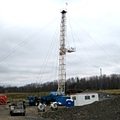- By Ellen Harrison
- News
 Print
Print  You don't have to be fracked to get fracked. Millions of New Yorkers are in the bulls-eye of a burgeoning oil and natural gas transport/delivery infrastructure currently under construction across the Empire State. But most of us don't even know it...yet.
You don't have to be fracked to get fracked. Millions of New Yorkers are in the bulls-eye of a burgeoning oil and natural gas transport/delivery infrastructure currently under construction across the Empire State. But most of us don't even know it...yet."All companies in the oil and gas industry agree that the name of the game right now is rolling out as much infrastructure as quickly as possible," said David Slottje, an internationally renowned environmental lawyer and activist at an all-day conference at Ithaca College examining the industrial build-out associated with fracking. The conference was convened by the Coalition to Protect Communities from Fracking's Collateral Damage.
The Coalition assembled an all-star faculty comprised of local government officials, lawyers and grassroots organizers who presented copious data showing that New York State is quickly becoming a vast and treacherous maze of pipelines, compressor stations, storage and export facilities. The conference was attended by more than 200 registrants from 36 counties in New York and also some from neighboring states.
Ellen Harrison, Chair of the Coalition said, "According to Bloomberg News, more than 21 billion dollars of pipelines and associated structures are planned to move natural gas from the Marcellus Shale underlying Pennsylvania and New York to points north and south."
"This is happening as we speak," said Harrison. One of the speakers, Maura Stephens, described an ongoing mapping project—YouAreHereNYmap.org--an excellent public resource that tracks and displays the ongoing process of turning New York into a gigantic natural gas transport and storage network. Another set of maps at at www.fractracker.org/ show national build-out, accidents and proximity to schools.
While public perceptions of the dangers of fracking itself (air pollution, industrialized water consumption, socioeconomic dislocations, etc.) are fairly well established in New York and other locations like Pennsylvania, Texas, Colorado, and the Dakotas, etc., where the process is rampant, relatively few people appreciate the collateral dangers associated with pipelines, storage facilities, compressor stations and other infrastructure. And there are concomitant problems such as the disposal of radioactive fracking waste in local landfills and the use of toxic fracking brine on local roads as "salt."
The over-riding message of the conference was that local communities must take responsibility for protecting themselves against the ongoing build-out. The Federal Government clearly has abdicated responsibility for protecting the population from the dangers of fossil fuel extraction.
"This is not surprising in that the majority of our law-makers (for example, the incoming Congress the majority of whom are Republicans) don't even believe in climate change," noted Harrison.
Similarly the New York State Department of Environmental Conservation (DEC) in Albany has sided with the energy industry on innumerable issues. Now that Governor Cuomo has been reelected she and other panelists fear he will indeed okay fracking in "communities that want it" despite the polls showing that nowhere do the majority of citizens want fracking in their community. Meanwhile the invasion of infrastructure construction continues unabated.
Some panelists, such as Mary Menapace, RN, from the Stop I-81 Pipeline group detailed successful attempts to block energy infrastructure build-out. She described effective tactics used to block a large gas pipeline proposed to run from Binghamton to Syracuse along I-81. On the other hand Pramilla Malik reported on a valiant but failed attempt to block a compressor station in Minisink, NY. The Federal Energy Regulatory Commission refused to approve even the minor request to move the proposed compressor further from residents. Now that this compressor station has been built, local residents (including many children) are experiencing rashes, nosebleeds and other respiratory problems: over 200 families are at risk of similar health problems from toxic air as well as injury from explosions.
Margie Rodgers of Gas Free Seneca reported on an ongoing battle against storing natural gas in vast salt caverns underlying Seneca Lake that supplies water for 100,000 people and at least 21 vineyards. Dozens of local activists have been arrested to date in this ongoing struggle. Several panelists asserted that given the failure of federal and state governments to protect communities, direct action is one of the only avenues left for those who decry the widespread development of energy infrastructure in New York and elsewhere.
The ongoing dispute regarding Seneca Lake is typical of the state-wide struggle against oil and gas infrastructure. Peter Mantius, a journalist from Corning, NY, noted that Crestwood, the company hoping to store liquid petroleum gas (LPG) in the crumbling caverns below Seneca Lake, "has repeatedly hidden damning evidence from both the public and the regulators." And they have a willing assistant in this endeavor—the DEC itself that is presumably supposed to be evaluating the storage proposal. "The DEC still keeps key parts of the company's 'reservoir suitability report' under lock and key," maintains Mantius. Thus these critical documents are not in the public record.
Panelists detailed reports of similar apparent collusion between state regulators and those presumably being regulated in other NY Communities.
v10i44



